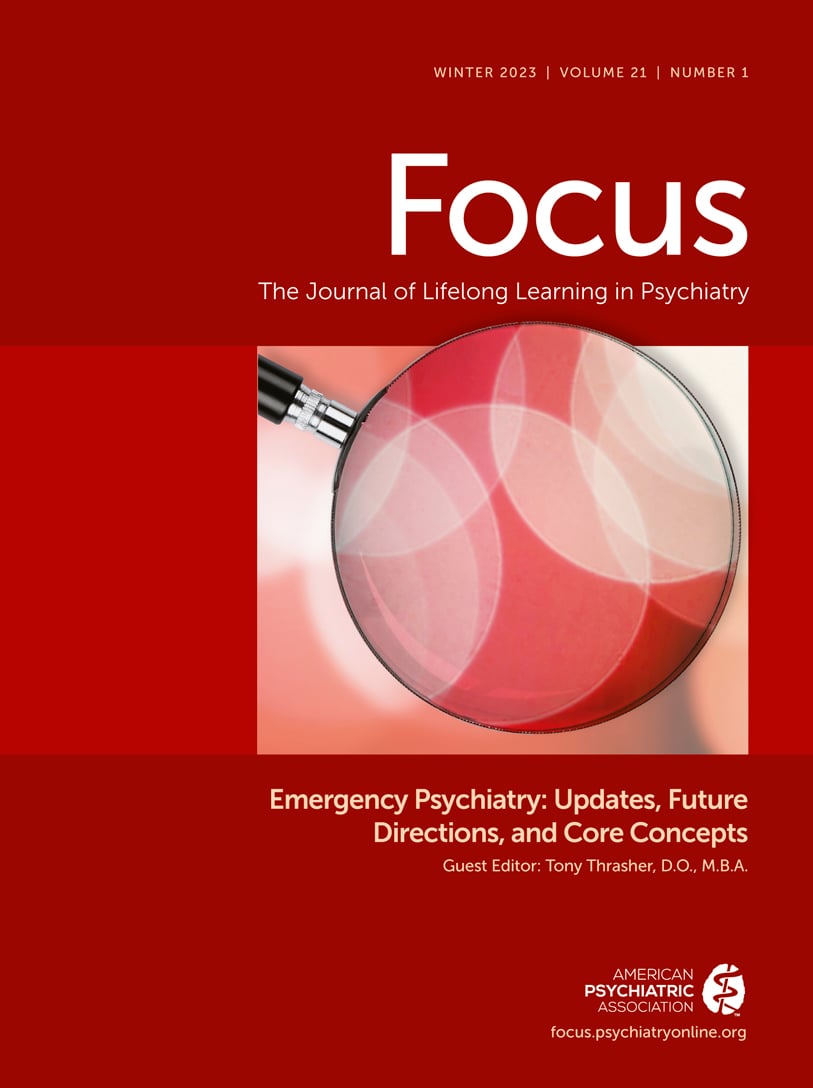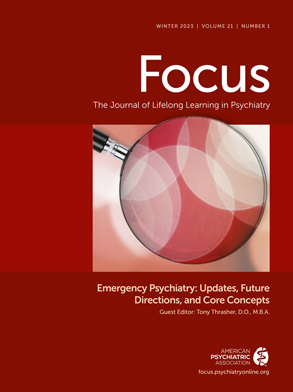Given space limitations and varying reprint permission policies, not all of the influential publications the editors considered reprinting in this issue could be included. This section contains abstracts from additional articles the editors deemed well worth reviewing.
American Association for Emergency Psychiatry Recommendations to Address Psychiatric Staff Shortages in Emergency Settings
Richmond JS, Dragatsi D, Stiebel V, et al.
Psychiatric Serv 2021; 72:437–443
OBJECTIVE: The psychological sequelae of the COVID-19 crisis will increase demands for psychiatric care in already strained emergency and mental health systems. To address the shortage of psychiatrists (and nurse practitioners and physician assistants) in emergency settings (ESs), the American Association for Emergency Psychiatry (AAEP) has established recommendations for utilizing nonprescribing mental health professionals in the evaluation and management of psychiatric patients in these contexts.
METHODS: Faced with limited research on the roles and competencies of nonprescribing psychiatric emergency clinicians (PECs), a multidisciplinary committee of members of AAEP was tasked with developing recommendations for use of PECs.
RESULTS: The committee developed eight recommendations regarding the role of PECs in evaluation and management of patients who present to ESs with behavioral emergencies. PECs should have the following competencies: conducting independent psychiatric and substance abuse evaluations; managing behavioral emergencies; aiding in the recognition of confounding medical illnesses, intoxication and withdrawal states, and adverse drug reactions; developing appropriate treatment plans; recognizing when consultation from a psychiatrist or emergency physician is indicated; possessing self-awareness and recognizing clinician-patient dynamics; understanding medicolegal issues, such as involuntary holds and decision-making capacity; and collaborating with clinical teams in ESs. PECs are not meant to replace psychiatrists but to extend the psychiatrist’s reach. Use of PECs has already been implemented in some areas of the country.
CONCLUSIONS: On the basis of the AAEP recommendations, ESs can address staffing shortages while ensuring safe management of patients with behavioral emergencies. With appropriate orientation and training, the PEC can serve effectively and competently in an ES.
Copyright 2021. Reprinted with permission.
Feasibility of Peer-Delivered Suicide Safety Planning in the Emergency Department: Results From a Pilot Trial
Wilson MP, Waliski A, Thompson G, Jr.
Psychiatr Serv 2022; 73:1087–1093
OBJECTIVE: The emergency department (ED) is an important site for suicide prevention efforts, and safety planning has been identified as a best practice for suicide prevention among ED patients at increased suicide risk. However, few ED clinicians are prepared to assess suicide risk or guide patients in the creation of safety plans. This study was a pilot randomized controlled trial of the feasibility, acceptability, and preliminary effects of safety planning by individuals with lived experience of suicide attempt or of severe suicidal ideation but without medical training (i.e., peers) in the ED.
METHODS: Patients at risk for suicide in a general ED were randomly assigned to receive peer-delivered or mental health provider–delivered safety planning. Intervention feasibility measures included ED length of stay, safety plan completeness, and safety plan quality. Acceptability measures included patient satisfaction. Preliminary effects were assessed as number of ED returns within the 3 months after the ED visit.
RESULTS: Data from 31 participants were available for analysis. Compared with participants with provider-delivered safety planning, participants with peer-delivered safety planning had similar ED lengths of stay, higher safety plan completeness, and higher safety plan quality. Acceptability of the safety planning process was similar for the two groups. Compared with participants receiving provider-delivered safety planning, participants receiving peer-delivered planning had significantly fewer ED visits during the subsequent 3 months than during the 3 months preceding the ED visit.
CONCLUSIONS: Peer-delivered safety planning is feasible and acceptable and may result in fewer return ED visits. These findings provide preliminary support for peer-delivered safety planning in the ED.
Copyright 2022. Reprinted with permission.
Proactive Detection (PROTECT) and Safety Planning to Shorten Emergency Department Stays for Psychiatric Patients
Kar Ray M, Theodoros T, Wyder M, et al.
OBJECTIVE: A literature gap exists for interventions to decrease average length of stay (ALOS) for patients with psychiatric presentations at the emergency department (ED). Long ALOSs are often related to sequential assessments of patients with high suicide risk or patients awaiting an inpatient bed. Safety planning may provide opportunities for diverting patients to the community and for reducing EDALOS. This study reports on the impact of a safety-planning approach based on the PROTECT (proactive detection) framework for suicide prevention.
METHODS: A complex intervention (comprising leadership, governance, and innovation) was instrumental in embedding a new clinical culture of proactive detection and positive risk management through safety planning at Princess Alexandra Hospital in Brisbane, Queensland, Australia. Practice as usual continued at a comparator nonintervention site (NIS). In total, 24,515 psychiatric presentations over 24 months were grouped into monthly averages for key outcomes, providing a sample size of 24 at each site. A difference-in-differences analysis across sites, preintervention (January–November 2019) and postimplementation (December 2019–December 2020), was used to estimate the intervention’s impact.
RESULTS: ED ALOS for psychiatric presentations, patients with an ALOS >12 hours, patients with an ALOS >24 hours, and inpatient psychiatric admissions decreased significantly compared with NIS (p<0.01) pre- and postimplementation of the safety-planning intervention.
CONCLUSIONS: Embedding a recovery-oriented culture of safety significantly reduced ED ALOS for psychiatric evaluations. Leadership, governance, and innovative practices that shift the focus of assessment and care from a mindset of risk prediction to one of prevention through collaborative safety planning as outlined in the PROTECT framework may have far-reaching benefits for patient care.
Copyright 2022. Reprinted with permission.
Medical Screening of Mental Health Patients in the Emergency Department: A Systematic Review
Chennapan K, Mullinax S, Anderson E, et al.
J Emerg Med 2018; 55:799–812
BACKGROUND: Patients presenting to the emergency department (ED) with psychiatric complaints often require medical screening to evaluate for a medical cause of their symptoms.
OBJECTIVE: We sought to evaluate the existing literature on the medical screening of psychiatric patients and establish recommendations for ideal screening practices in Western-style EDs.
METHODS: PubMed, PsycINFO, and
ClinicalTrials.gov were searched for clinical studies examining the medical screening of adult psychiatric patients in the ED or inappropriate referrals to psychiatry. Articles were graded using the Effective Public Health Practice Project (EPHPP) grading tool and sorted into topics. A 3-level grading algorithm used by other emergency medicine organizations was used to evaluate the strength of the evidence for each recommendation.
RESULTS: Sixty articles met the inclusion and exclusion criteria. Most published literature on medical screening consisted of nonrandomized studies with a high risk of bias. Some screening procedures, such as history and physical examination, were extensively recommended. Other screening procedures received mixed recommendations.
CONCLUSIONS: Based on available literature, physician experts developed 7 recommendations. For a patient with known psychiatric disease presenting with symptom exacerbation, medical screening should include a full medical and psychiatric history, a targeted physical examination, and a mental status examination. Urine toxicology screening and nonurine drug screen laboratory testing should not be routinely performed. Additional screening tests may be valuable for patients with new-onset psychiatric symptoms who are ≥65 years of age, are immunosuppressed, or have concomitant medical disease. However, additional studies on this topic with more rigorous methodology must be conducted to establish definitive guidelines.
Copyright 2018 Elsevier. Reprinted with permission.

